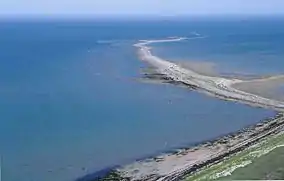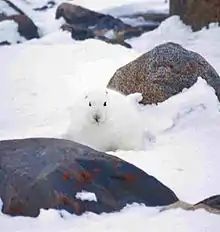Wapusk National Park
Wapusk National Park (/wəˈpʌsk/;[1] French: Parc national Wapusk) is Canada's 37th national park, established in 1996. The park is located in the Hudson Plains ecozone, 45 kilometres (28 mi) south of Churchill in north-east Manitoba, Canada, on the shores of Hudson Bay. Access to the park is limited due to its remote location and an effort to preserve the park. The name comes from the Cree word for polar bear (wâpask).[2] The Park is also home to Cape Churchill, which is renowned as the best location in the world to view and photograph wild polar bears. The only way people can access Cape Churchill is by helicopter or Tundra Buggy.
| Wapusk National Parks | |
|---|---|
IUCN category II (national park) | |
 Cape Churchill in summertime | |
 Location of Wapusk National Park in Canada | |
| Location | Manitoba, Canada |
| Nearest city | Churchill |
| Coordinates | 57°46′26″N 93°22′17″W |
| Area | 11,475 km2 (4,431 sq mi) |
| Established | 1996 |
| Governing body | Parks Canada |
| Website | Wapusk National Park |
The park was the subject of a short film in 2011's National Parks Project, directed by Hubert Davis and scored by Kathleen Edwards, Matt Mays and Sam Roberts.[3]
Overview
Wapusk is the Cree word for "white bear", and as the meaning indicates, the 11,475-square-kilometre (4,430 sq mi) park is a significant maternity denning area for the polar bear, Ursus maritimus.[4] It includes a large part of the Hudson Bay Lowlands, a subarctic region bordering Hudson Bay that is mostly muskeg and wet peatlands. It is one of the wildest and most remote of Canadian landscapes.
In winter, the Polar Bears of Wapusk National Park come ashore as the ice on the Hudson Bay melts, waiting on the tundra until the water freeze again. Pregnant females remain ashore, sheltered in maternity dens within the peatlands in Wapusk, giving birth over the season.[5]
Numerous birds are found in the Wapusk National Park and it is a likely breeding area of the short-billed dowitcher.[6]
In a 2010 report biologists affiliated with the American Museum of Natural History and City College of the City University of New York have prepared a new report published in Canadian Field-Naturalist that offers the first documented evidence the temperamental grizzly bears are migrating into polar bear territory. Researchers found that seven grizzlies have been spotted in Wapusk National Park south of Churchill, between 2003 and 2008.[7][8]
Fauna
This national park is home to animals such as polar bears, great grey owls, timber wolves, lemmings, ivory gulls, two species of fox, peregrine falcons, snowshoe hares, moose, wolverines, Caspian terns, and a herd of 3000 Cape Churchill caribou.
Rivers
Gallery
 Snowshoe hare
Snowshoe hare Willow ptarmigan
Willow ptarmigan Polar bear at Cape Churchill
Polar bear at Cape Churchill Northern Lights
Northern Lights
References
- Parks Canada (2017-07-26). Parks Can Can Canada 2017. Retrieved 2019-05-19.
- "Search Results for: wâpask". Online Cree Dictionary. Retrieved 2012-07-08.
- Parks Canada Agency, Government of Canada (14 September 2011). "Music and Film - Inspired by Wapusk - Wapusk National Park". pc.gc.ca. Retrieved 28 April 2020.
- Hogan, C Michael (2008-11-18). "Polar Bear: Ursus maritimus". GlobalTwitcher. Archived from the original on 2012-03-08. Retrieved 2012-07-08.
- Parks Canada Agency, Government of Canada (2017-06-29). "About - Wapusk National Park". www.pc.gc.ca. Retrieved 2019-06-18.
- Wells, Jeffrey Vance (2007). Birder's Conservation Handbook: 100 North American Birds at Risk. Princeton: Princeton University Press. ISBN 9780691123226. OCLC 124031808.
- Walton, Doreen (2010-02-24). "Grizzlies encroach on polar bear territory". BBC News. Retrieved 2012-07-08.
- "Grizzly Bears Move Into Polar Bear Habitat in Manitoba, Canada". Science Daily. 2010-02-23. Retrieved 2012-07-08.